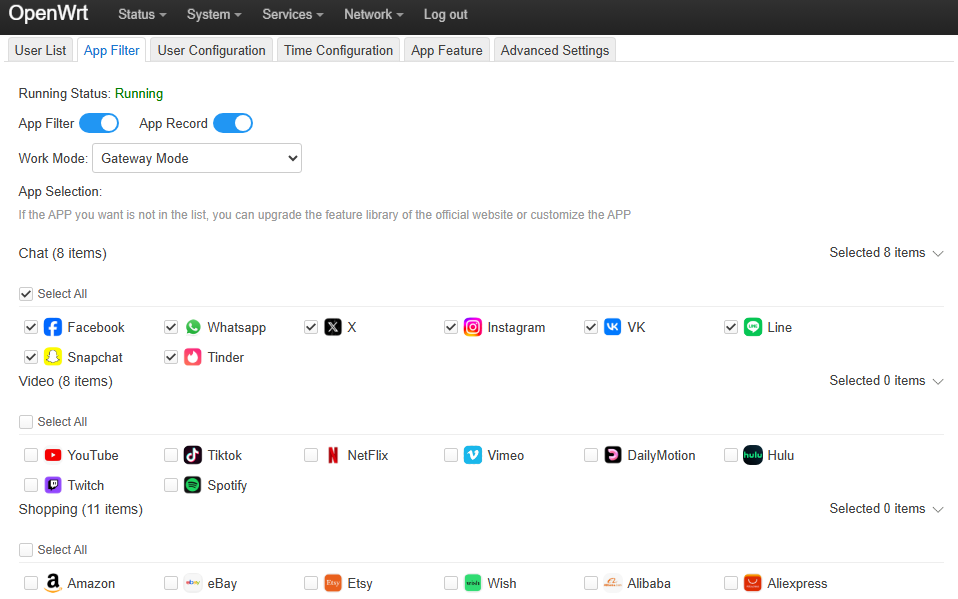What is OpenWrt?
OpenWrt is a Linux-based open-source operating system designed for embedded devices, primarily routers. It provides a fully writable filesystem with package management, allowing users to customize their router’s functionality beyond what stock firmware offers.
Key Features of OpenWrt:
- Full Control: Complete access to the router’s operating system
- Package Management: Install thousands of software packages via opkg
- Customization: Modify network settings, firewall rules, and routing behavior
- Security: Regular security updates and patches from the community
- Advanced Features: VPN support, QoS, traffic shaping, mesh networking, and more
- Privacy: No telemetry or data collection by default
- Community Support: Active community providing help and custom builds
Why Choose OpenWrt?
- Enhanced Privacy: No backdoors or data collection
- Better Performance: Optimized for your specific use case
- Advanced Networking: Support for VLANs, multiple SSIDs, and complex routing
- VPN Integration: Built-in support for WireGuard, OpenVPN, and other VPN protocols
- Ad Blocking: Install ad-blocking packages like AdBlock or AdGuard Home
- Extended Lifespan: Keep older routers updated with security patches
- Learning Opportunity: Great way to learn Linux networking
Understanding Router Hardware Specifications
Before choosing a router, it’s essential to understand what hardware specifications matter for OpenWrt:
CPU (Processor)
- Architecture: ARM-based processors (Cortex-A53, A7) are preferred over MIPS
- Cores: More cores generally mean better performance, especially for VPN and QoS
- Clock Speed: Higher GHz means faster processing
- Popular Chips: MediaTek MT7981/MT7986, Qualcomm IPQ series, Marvell Armada
RAM (Memory)
- Minimum: 64 MB (basic functionality)
- Recommended: 128-256 MB (comfortable for most users)
- Ideal: 512 MB+ (for advanced features, VPN, and many packages)
- Impact: More RAM allows more packages and better multitasking
Flash Storage
- Minimum: 16 MB (basic OpenWrt installation)
- Recommended: 128 MB (room for packages and configurations)
- Ideal: 256 MB+ or eMMC (extensive package installation)
- Types: NAND flash (traditional) or eMMC (more space, faster)
WiFi Standards
- WiFi 5 (AC): Dual-band, good performance
- WiFi 6 (AX): Latest standard, better range and efficiency
- Bands: Dual-band (2.4 GHz + 5 GHz) is standard, tri-band adds extra 5 GHz
Ethernet Ports
- Gigabit (1 Gbps): Standard for most routers
- 2.5G/5G/10G: Future-proofing for faster internet connections
- Port Count: More ports allow more wired devices
USB Ports
- USB 2.0/3.0: For external storage, printers, or 4G/5G modems
- Useful For: Network-attached storage (NAS), media servers
How to Choose the Right OpenWrt Router
Step 1: Determine Your Needs
Ask yourself:
- Budget: How much are you willing to spend?
- Use Case: Basic routing, VPN server, NAS, mesh networking?
- Internet Speed: What’s your internet connection speed?
- Coverage Area: How large is the area you need to cover?
- Device Count: How many devices will connect simultaneously?
- Technical Skill: Beginner, intermediate, or advanced user?
Step 2: Check OpenWrt Compatibility
Critical: Always verify compatibility before purchasing!
- Visit OpenWrt Hardware Table: https://openwrt.org/toh/start
- Search for your router model: Exact model number matters
- Check hardware version: Different versions may have different chips
- Review support status: Look for “Supported” or “Supported (Current Release)”
- Read forum threads: Check for known issues or special instructions
Step 3: Evaluate Hardware Specifications
For Basic Users:
- CPU: Dual-core 1.0+ GHz
- RAM: 128 MB minimum
- Flash: 16-32 MB
- WiFi: AC1200 or better
- Price: $40-80
For Intermediate Users:
- CPU: Dual-core 1.3+ GHz or Quad-core
- RAM: 256-512 MB
- Flash: 128 MB
- WiFi: AC1750 or AX3000
- Price: $80-150
For Advanced Users:
- CPU: Quad-core 1.8+ GHz
- RAM: 512 MB – 1 GB+
- Flash: 128 MB+ or eMMC
- WiFi: AX6000 or better
- Ethernet: 2.5G ports preferred
- Price: $150-250+
Step 4: Consider Brand and Community Support
Best Brands for OpenWrt:
- GL.iNet: Pre-installed OpenWrt, excellent support
- TP-Link: Strong OpenWrt support, especially XDR series
- Linksys WRT Series: Designed for open-source
- Netgear: Select models have excellent support
- Banana Pi: Development boards with great documentation
Community Support Factors:
- Active forum discussions
- Regular firmware updates
- Custom builds available
- Good documentation
Step 5: Verify Hardware Version
Important: The same model number can have different hardware versions with different chips!
- Check the label on the router for hardware version (e.g., “v1”, “v2”, “v4”)
- Different versions may require different firmware files
- Some versions may not be supported at all
- Always confirm before purchasing
Recommended Routers for OpenWrt (2024-2025)
🔥 Top Picks: MediaTek MT7981/MT7986 Series
These are the most popular and well-supported routers in 2024-2025, featuring modern WiFi 6 support and excellent OpenWrt compatibility.
High-Performance Options (MT7986 – Quad-core 2.0 GHz)
1. GL.iNet GL-MT6000 (Flint 2)
- CPU: MediaTek MT7986A Quad-core A53 2.0 GHz
- RAM: 1 GB
- Flash: 8 GB eMMC
- WiFi: Dual-band AX6000 (WiFi 6)
- Ethernet: 4x Gigabit + 2x 2.5G
- USB: USB 3.0
- OpenWrt Support: Excellent, pre-installed
- Price: $150-200
- Best For: Power users, VPN servers, NAS applications
- Why Choose: Best-in-class hardware, comes with OpenWrt pre-installed, no flashing needed
2. TP-Link Archer AX6000 (XDR6088)
- CPU: MediaTek MT7986A Quad-core A53 2.0 GHz
- RAM: 512 MB
- Flash: 128 MB
- WiFi: Dual-band AX6000 (WiFi 6)
- Ethernet: 4x Gigabit + 2x 2.5G
- OpenWrt Support: Excellent, official support
- Price: $120-180
- Best For: Advanced users wanting high performance
- Why Choose: Excellent value, very popular, strong community support
3. Banana Pi BPI-R3 Mini
- CPU: MediaTek MT7986 Quad-core A53 2.0 GHz
- RAM: 2 GB
- Flash: 8 GB eMMC
- WiFi: Dual-band AX6000 (WiFi 6)
- Ethernet: 2x 2.5G
- USB: USB 3.0
- OpenWrt Support: Excellent, official support
- Price: $100-150
- Best For: Developers, advanced users, learning
- Why Choose: Development board with excellent documentation, 2GB RAM
4. Netcore N60 Pro
- CPU: MediaTek MT7986A Quad-core A53 2.0 GHz
- RAM: 512 MB
- Flash: 128 MB
- WiFi: Dual-band AX6000 (WiFi 6)
- Ethernet: 2x 2.5G
- USB: USB 3.0
- OpenWrt Support: Good, community support
- Price: $80-120
- Best For: Budget-conscious users wanting 2.5G ports
- Why Choose: Affordable option with modern features
Mid-Range Options (MT7981 – Dual-core 1.3 GHz)
5. CMCC RAX3000M (International Variants)
- CPU: MediaTek MT7981B Dual-core A53 1.3 GHz
- RAM: 512 MB
- Flash: 64 GB eMMC (some variants) / 128 MB NAND
- WiFi: Dual-band AX3000 (WiFi 6)
- Ethernet: 4x Gigabit
- USB: USB 3.0 (some variants)
- OpenWrt Support: Excellent, very popular in 2024
- Price: $40-60
- Best For: Budget users, beginners
- Why Choose: Extremely popular, excellent value, great OpenWrt support
6. TP-Link Archer AX3000 (XDR3020/XDR3040)
- CPU: MediaTek MT7981B Dual-core A53 1.3 GHz
- RAM: 256-512 MB
- Flash: 128 MB
- WiFi: Dual-band AX3000 (WiFi 6)
- Ethernet: 4x Gigabit
- OpenWrt Support: Good, official/community support
- Price: $60-90
- Best For: Reliable mid-range option
- Why Choose: TP-Link build quality, good OpenWrt compatibility
7. Xiaomi AX3000T / Redmi AX6000 (International Versions)
- CPU: MediaTek MT7981B Dual-core A53 1.3 GHz
- RAM: 256-512 MB
- Flash: 128 MB
- WiFi: Dual-band AX3000 (WiFi 6)
- Ethernet: 4x Gigabit
- OpenWrt Support: Good, community support
- Price: $50-80
- Best For: Value-conscious users
- Why Choose: Good value, check international availability
Legacy/Alternative Options
8. Netgear R7800 (Nighthawk X4S AC2600)
- CPU: Qualcomm IPQ8065 Dual-core 1.7 GHz
- RAM: 512 MB
- Flash: 128 MB
- WiFi: Dual-band AC2600
- OpenWrt Support: Excellent, official support
- Price: $150-200
- Best For: Users wanting proven reliability
- Why Choose: Very popular for OpenWrt, excellent performance
9. Linksys WRT3200ACM
- CPU: Marvell Armada 385 Dual-core 1.8 GHz
- RAM: 512 MB
- Flash: 256 MB
- WiFi: Tri-band AC3200
- OpenWrt Support: Excellent, official support
- Price: $150-250
- Best For: Users wanting tri-band WiFi
- Why Choose: Designed with open-source in mind, great community support
10. Linksys WRT1900ACS
- CPU: Marvell Armada 385 Dual-core 1.6 GHz
- RAM: 512 MB
- Flash: 128 MB
- WiFi: Dual-band AC1900
- OpenWrt Support: Excellent, official support
- Price: $100-150
- Best For: Classic OpenWrt-friendly option
- Why Choose: Classic OpenWrt-friendly router
11. TP-Link Archer C7 v2/v4 (AC1750)
- CPU: Qualcomm QCA9558 720 MHz
- RAM: 128 MB
- Flash: 16 MB
- WiFi: Dual-band AC1750
- OpenWrt Support: Good, official support
- Price: $50-80
- Best For: Beginners, budget users
- Why Choose: Budget-friendly, widely available, good for learning
12. GL.iNet Routers (Various Models)
- Popular Models: GL-AX1800 (Flint), GL-MT3000 (Beryl AX), GL-AR750S (Slate)
- OpenWrt Support: Excellent, pre-installed
- Price: $50-150
- Best For: Users who want OpenWrt without flashing
- Why Choose: Come with OpenWrt pre-installed, very user-friendly
Selection Guide by Use Case
For Beginners
Recommended: GL.iNet routers, TP-Link Archer C7, CMCC RAX3000M
- Pre-installed or easy-to-flash OpenWrt
- Good documentation
- Active community support
- Budget-friendly
For VPN Servers
Recommended: GL.iNet GL-MT6000, TP-Link XDR6088, Banana Pi BPI-R3 Mini
- Quad-core CPU recommended
- 512 MB+ RAM
- Good for WireGuard, OpenVPN
For NAS/Media Server
Recommended: GL.iNet GL-MT6000, Banana Pi BPI-R3 Mini
- USB 3.0 port
- eMMC storage preferred
- High RAM (512 MB+)
For High-Speed Internet (1 Gbps+)
Recommended: GL.iNet GL-MT6000, TP-Link XDR6088, Netcore N60 Pro
- 2.5G Ethernet ports
- Quad-core CPU
- High RAM
For Mesh Networking
Recommended: Any supported router with good WiFi 6 support
- Multiple units needed
- Check for mesh support in OpenWrt
- Consider GL.iNet models with mesh features
For Learning/Development
Recommended: Banana Pi BPI-R3 Mini, GL.iNet routers
- Good documentation
- Development-friendly
- Active community
Important Considerations
Before Purchasing Checklist
- ✅ Verify OpenWrt Compatibility
- Check exact model number on OpenWrt hardware table
- Confirm hardware version compatibility
- Read forum discussions for known issues
- ✅ Check Hardware Specifications
- Minimum 16 MB flash (128 MB recommended)
- Minimum 64 MB RAM (128 MB+ recommended)
- Verify WiFi standard meets your needs
- ✅ Research Flashing Process
- Some routers are easier to flash than others
- Check if special tools or methods are needed
- Look for step-by-step guides
- ✅ Consider Warranty
- Flashing may void warranty
- Consider buying used/refurbished for testing
- GL.iNet routers come with OpenWrt, warranty intact
- ✅ Check Availability
- Some models may be region-specific
- Verify international shipping if needed
- Check for international variants
Common Pitfalls to Avoid
- ❌ Buying Wrong Hardware Version: Same model, different chip
- ❌ Insufficient Flash/RAM: Can’t install desired packages
- ❌ No OpenWrt Support: Router not compatible
- ❌ Region Lock: Some routers locked to specific regions
- ❌ Difficult Flashing: Some routers require special tools
Resources and Further Reading
Official Resources
- OpenWrt Website: https://openwrt.org/
- Hardware Compatibility Table: https://openwrt.org/toh/start
- OpenWrt Forum: https://forum.openwrt.org/
- OpenWrt Wiki: https://openwrt.org/docs/guide-user/start
Community Resources
- OpenWrt Subreddit: r/openwrt
- MediaTek Filogic Info: Search “MT7981” or “MT7986” on OpenWrt forum
- Custom Builds: Check forum for community-maintained builds
Recommended Brands
- GL.iNet: Pre-installed OpenWrt, excellent support
- TP-Link: Strong MT7981/MT7986 support, especially XDR series
- Linksys WRT Series: Designed for open-source
- Netgear: Select models have excellent support
- Banana Pi: Development boards with great documentation
Conclusion
Choosing the right OpenWrt router depends on your needs, budget, and technical skill level. The MediaTek MT7981/MT7986 series routers are currently the best choices for 2024-2025, offering modern WiFi 6 support, excellent performance, and strong OpenWrt compatibility.
Quick Recommendations:
- Best Overall: GL.iNet GL-MT6000 (pre-installed OpenWrt)
- Best Value: CMCC RAX3000M or TP-Link XDR6088
- Best for Beginners: GL.iNet routers (pre-installed) or TP-Link Archer C7
- Best for Advanced Users: Banana Pi BPI-R3 Mini or TP-Link XDR6088
Remember to always verify compatibility on the OpenWrt hardware table before making a purchase, and join the OpenWrt community for support and updates!



